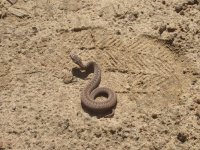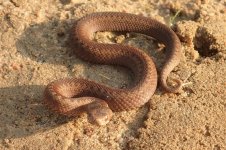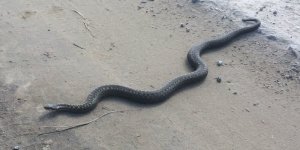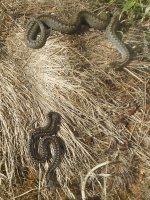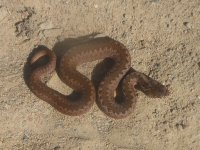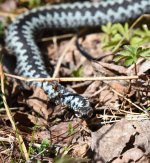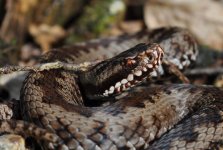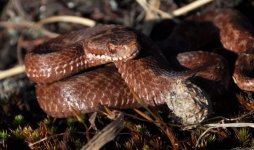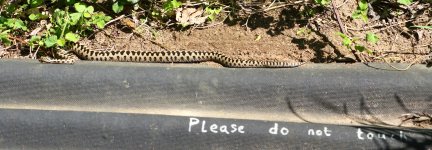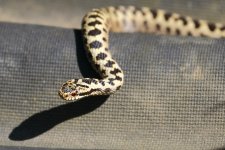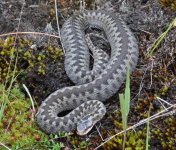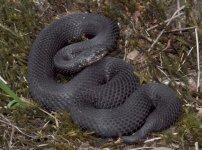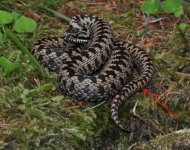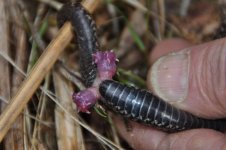-
Welcome to BirdForum, the internet's largest birding community with thousands of members from all over the world. The forums are dedicated to wild birds, birding, binoculars and equipment and all that goes with it.
Please register for an account to take part in the discussions in the forum, post your pictures in the gallery and more.
You are using an out of date browser. It may not display this or other websites correctly.
You should upgrade or use an alternative browser.
You should upgrade or use an alternative browser.
Aging Adder (1 Viewer)
- Thread starter jackied
- Start date
More options
Who Replied?Farnboro John
Well-known member
I doubt that it would be one of this year's (2019) hatchlings in mid April. My guess would be born last year.
Yep. Mating is in spring, births in late summer. Small thin snakes at this time of year are last year's young.
John
Andy Adcock
Worst person on Birdforum

I'd like to know why males are so infrequently seen?
During my time in Russia, Adders were common on my local patch but in 5 years, only two or three males were seen, the majority being mid sized females and very young animals.
During my time in Russia, Adders were common on my local patch but in 5 years, only two or three males were seen, the majority being mid sized females and very young animals.
Farnboro John
Well-known member
I'd like to know why males are so infrequently seen?
During my time in Russia, Adders were common on my local patch but in 5 years, only two or three males were seen, the majority being mid sized females and very young animals.
I admit that until you posted this it hadn't occurred to me that male Adders aren't seen as frequently as females. It doesn't seem to be an issue round here, at Pulborough or down in Dorset where I see most of my Adders.
However, I can offer a suggestion as to why some might have a bias in their observations: reading up on Adder sexing produces the fact that males have an even taper towards the tail whereas females remain broad almost all the way down and then have an abrupt narrowing followed by a narrow tail (making the tail rather more obvious as a structure).
But early in the season when Adders are seeking to maximise the solar heating they obtain, they all flatten out their bodies, broadening them along much of their length and creating the effect of a sudden narrowing where they run out of ribs. This could lead to misidentifying of males as females and a consequent bias towards reporting females.
Plausible?
John
A few weeks ago at a west London site that has a substantial Adder population we saw about 20 Adders basking on what had been a cool largely sun free morning. All but about 3 were identified by the reptile expert as male. I was very pleased to see my first (3) black Adders.
Andy Adcock
Worst person on Birdforum

OK, here's a small range of shots for your perusal,
I'll try to find more when I have time.
I think the lower animal in the 4th pic is a male based on tail shape? These were both under a refugium that I repurposed for the job.
I'll try to find more when I have time.
I think the lower animal in the 4th pic is a male based on tail shape? These were both under a refugium that I repurposed for the job.
Attachments
Last edited:
Andy Adcock
Worst person on Birdforum

Nigel Davies
Well-known member
Lovely photos Andy
Andy Adcock
Worst person on Birdforum

Lovely photos Andy
Thank you,
the first is probably one of that years young, it's in my footprint whilst the third, is the biggest we've ever seen there at about 70cm and is I'm fairly sure, a female.
Farnboro John
Well-known member
Well, in my opinion (others are available):
1. Can't tell, the critical bit is concealed beneath the snake!
2. Female.
3. Male for me: that looks like an evenly tapered tail. Big Adder!
4. Female top, male bottom.
5. Female.
'S not easy!
John
1. Can't tell, the critical bit is concealed beneath the snake!
2. Female.
3. Male for me: that looks like an evenly tapered tail. Big Adder!
4. Female top, male bottom.
5. Female.
'S not easy!
John
Andy Adcock
Worst person on Birdforum

Well, in my opinion (others are available):
1. Can't tell, the critical bit is concealed beneath the snake!
2. Female.
3. Male for me: that looks like an evenly tapered tail. Big Adder!
4. Female top, male bottom.
5. Female.
'S not easy!
John
Hmm,
when you say 'evenly tapered', I thought the males had a skinnier, longer tail, the tail on 3 is fairly shortish?
vipersgarden
Well-known member
Andy Adcock
Worst person on Birdforum

In young adders it is more easy to check the "nose"shields for sexing.
In males, the borders of the rostrale and the nasals have a strong contrasting border, while in females the shields are unicolored.
Thanks Viper, very usefull as I see many young animals.
Farnboro John
Well-known member
Hmm,
when you say 'evenly tapered', I thought the males had a skinnier, longer tail, the tail on 3 is fairly shortish?
I try to visualise the snake in a straight line. On a female Adder there is a distinct step between the main body and tail but on a male there is a continuous taper from further up the snake down into the tail region. (See photo below from Pulborough last year).
I liked Vipersgarden's tip but noted that even on his demonstration photos the difference seems to be a matter of degree rather than an absolute. The female scales were not concolorous, displaying the same border as in the male but admittedly with much less contrast.
John
Attachments
Andy Adcock
Worst person on Birdforum

I try to visualise the snake in a straight line. On a female Adder there is a distinct step between the main body and tail but on a male there is a continuous taper from further up the snake down into the tail region. (See photo below from Pulborough last year).
I liked Vipersgarden's tip but noted that even on his demonstration photos the difference seems to be a matter of degree rather than an absolute. The female scales were not concolorous, displaying the same border as in the male but admittedly with much less contrast.
John
I'd say the attached is a female John?
Males have a gradual taper giving the impression of a lonfer, skinnier tail where females tails are fatter and stumpier?
Farnboro John
Well-known member
Another view of the same snake. Contrasting borders on rostral scales = male according to Vipersgarden. And me. 
Also, what I see on the tail end is a smooth taper, not a distinct step as in a female (your no. 5 shows the female tail really well: its like the shoulders on a wine bottle). :t:
Have you got a closer view (or a crop at a pinch) of your No. 3's head?
John
Also, what I see on the tail end is a smooth taper, not a distinct step as in a female (your no. 5 shows the female tail really well: its like the shoulders on a wine bottle). :t:
Have you got a closer view (or a crop at a pinch) of your No. 3's head?
John
Attachments
Andy Adcock
Worst person on Birdforum

Another view of the same snake. Contrasting borders on rostral scales = male according to Vipersgarden. And me.
Also, what I see on the tail end is a smooth taper, not a distinct step as in a female (your no. 5 shows the female tail really well: its like the shoulders on a wine bottle). :t:
Have you got a closer view (or a crop at a pinch) of your No. 3's head?
John
No mate, it shot across the path double quick.
vipersgarden
Well-known member
yes John, it is a male for sure 
but dont give to much on the vipers colour. even females may be silvery grey.
On the pictures you see two females and one male. At the male's picture I have marked where the tail begins. The bump at the beginning of the tail are the pockets for the hemipenes.
but dont give to much on the vipers colour. even females may be silvery grey.
On the pictures you see two females and one male. At the male's picture I have marked where the tail begins. The bump at the beginning of the tail are the pockets for the hemipenes.
Attachments
Similar threads
Users who are viewing this thread
Total: 2 (members: 0, guests: 2)





